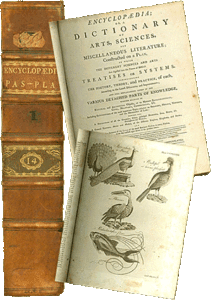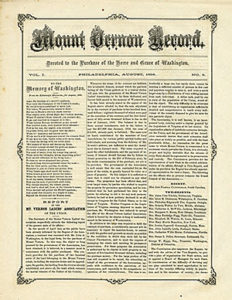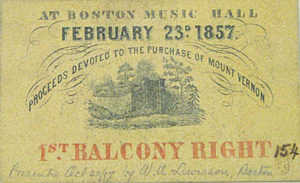Digital Encyclopedias and Opportunities

In September of 1797, George Washington wrote to Clement Biddle, the manager of his Philadelphia business affairs, requesting the purchase of an encyclopedia. The recently retired first president specified that he wanted two copies, for both practical and ideological reasons. On the one hand, he had promised to give one set of the encyclopedia to his secretary, Tobias Lear, and he also desired to have a copy for his own library. Just as importantly, Washington wanted to personally “encourage” the encyclopedia’s success by supporting the printer’s “undertaking the work” (fig. 1).
In the summer of 2011, George Washington’s Mount Vernon began its own search for an encyclopedia, though one published in a vastly different medium. The organization decided to pursue the development of a digital encyclopedia, aiming to create a central repository of information about Washington, his world, his estate, and the history of its preservation. With a new academic research library opening, Mount Vernon was eager to establish itself as a location for academic research and emerging scholarly technology. However, beyond a generalized idea that an online encyclopedia was necessary, the details of what the project would look like, how it would function, and what information it would provide remained to be determined.
I began working as the encyclopedia’s editor in June of 2011, fresh off completing my doctorate in American history. In addition to my background in academic history, my graduate training included a secondary field in public history as well as practical experience working on digital history projects, including a consideration of the 1919 Chicago race riot and a photographic documentation of immigrant history in New York City. However, these experiences were largely independent, supporting individual research projects rather than the broader goals of an institution. In anticipation of my new position, I wondered how my past experiences prepared me for this project. Further, as someone who had always planned a career in academia, how would my experience working at Mount Vernon satisfy my love of working directly with college-level students? The following essay explores the process of building the Digital Encyclopedia of George Washington in an attempt to answer these questions and as a means to understand the challenges and opportunities present in creating a large-scale digital history project.
Project description and goals
The ability to quickly and efficiently publish digital content provided the time to partner with writers on improving their essays rather than simply dictating changes.
Recent years have witnessed a proliferation of online, historically oriented encyclopedias, presumably in response to the popularity of (and equal parts skepticism toward) Wikipedia. For Mount Vernon, the opening of a new research library provided an ideal opportunity to develop and launch an academically oriented digital project. The Fred W. Smith National Library for the Study of George Washington opened in September of 2013. The library has three primary objectives. First, it collects and preserves books and letters of George Washington and enables scholars and students to access these materials. Second, the library features outreach programs that will give special attention to students and teachers. Last, as part of the new library’s mission, Mount Vernon has launched an ambitious fellowship program aimed at supporting the work of scholars of the Revolutionary era and early republic.
The Digital Encyclopedia of George Washington fits within the library’s overarching goal of providing the public with information and materials to facilitate the study of history. As outlined by the encyclopedia’s mission statement, the site serves as “the central location for historical information about George Washington, the Mount Vernon Estate, and the Mount Vernon Ladies’ Association (MVLA).” Founded in 1853, the MVLA is the oldest national historic preservation organization in the United States, and has owned and operated Mount Vernon since 1860. The library includes the MVLA’s institutional archives, which contain important documents in understanding the story of historic preservation in the United States. The opening of a new library presents an opportunity to make these materials more broadly available to both scholars and the public. To support this goal, the encyclopedia not only documents Washington’s life but also provides entries focusing on the history of the preservation of Mount Vernon.
One of the primary goals of the project is to present encyclopedia entries that serve as vehicles for the promotion and proliferation of primary source materials from Mount Vernon’s collections. Encyclopedia entries provide narrative context, while images illustrate material culture and offer access to primary source materials such as manuscripts, prints, fine and decorative art, and periodicals. The encyclopedia also includes short video clips of scholars commenting on issues related to entry subjects, a feature that will continue to expand, particularly with new scholars visiting Mount Vernon as fellows.
The encyclopedia aims to appeal to a broad user base, though three groups compose the core audience: history scholars, students, and teachers. Entries strike a balance between scholarly rigor and general accessibility. A focus on clear and concise language ensures that entries are accessible to a broad audience, not just scholars of the time period. And while the length of each article is limited to no more than 1,000 words, authors both provide basic information and develop a readable and compelling narrative.
In order to provide verifiable information and encourage further research on a topic, all entries have full footnote citations as well as a bibliography of secondary works cited in the essay. Footnotes include links to digitized sources, frequently connecting to the Papers of George Washington, Digital Edition. Similarly, whenever possible, the bibliography links to digitized copies of secondary source work. Entries also include a link to the Mount Vernon library catalogue for materials related to the subject that are housed in the new library, or with other members of the Founding Fathers Library Consortium, which currently includes the libraries at Gunston Hall (George Mason’s home) and Stratford Hall (the Lee family plantation).
Contributors
The digital encyclopedia is a collaborative project, bringing together contributions from Mount Vernon staff as well as a diverse group of scholars at various professional levels. Most authors have a background in American history, though a few art historians and scholars of American literature are also represented. Moving forward, fellows researching in the new library will also have opportunities to write for the encyclopedia, particularly on topics relevant to their work undertaken at Mount Vernon.
The majority of our contributors are either PhDs or en route to completing their doctorates. Writers are largely recruited through a formal call for papers that has appeared on the websites of professional history organizations and related disciplines. It was important for the project to engage scholarly experts to emphasize the quality and accuracy of the encyclopedia’s content. On a personal level, interaction with the writers has been one of the more rewarding aspects of this project, leading to any number of interesting discussions on historical topics both related and unrelated to Washington and Mount Vernon, as well as exposure to a broad range of research interests and publications produced by contributors.
A Web environment presents a rare opportunity with respect to the editorial and peer review processes. The ability to quickly and efficiently publish digital content provided the time to partner with writers on improving their essays rather than simply dictating changes. Collaboration was particularly important for development of the Digital Encyclopedia of George Washington, as entries are intended to be Washington-centric. Some excellent entries were written as first drafts that were general in tone, providing a broad, encyclopedic overview of a topic. These entries needed to be re-crafted with attention to the subject’s Washington or Mount Vernon connection. Working in tandem with writers ensured that these well-written pieces would appear in the style necessary for inclusion in this particular encyclopedia.
Structure and content
The encyclopedia’s taxonomy consists of eighteen different categories, organizing entries by subject. Topics encompass a range of fields including social, cultural, military, political, and culinary history (a topic recently explored in Mount Vernon’s museum). This approach is meant to support Mount Vernon’s mission of educating the public in all aspects of Washington’s life and legacy. The method also attempts to make Washington’s nearly mythological stature more approachable and resonant. As a result, the encyclopedia has the conventionally expected entries on topics such as the crossing of the Delaware River on Christmas night, 1776 and the mythology surrounding Washington’s false teeth. However, other entries consider more esoteric topics connected with Washington and collective memory, such as pieces on Washington’s birthday centennial, and portrayals of Washington in popular culture.
The encyclopedia also explores the history of Mount Vernon as a plantation, estate, and community in the eighteenth and nineteenth centuries. To represent daily life at Mount Vernon, the encyclopedia provides a wide variety of entries, including ones on the plantation’s structure, the physical growth of Washington’s land holdings, and slavery at Mount Vernon. The encyclopedia further considers Mount Vernon’s place in culture, with entries ranging from Henry James’s short story “Pandora” (which features Mount Vernon prominently in its climactic scene), to an exploration of pilgrimages to Mount Vernon in the nineteenth century. Finally, the encyclopedia focuses on the history of preservation at Mount Vernon, with entries on subjects such as MVLA founder Ann Pamela Cunningham, the early activities of the Mount Vernon Ladies’ Association, and Mount Vernon during the Civil War.
The essay on Edward Everett is instructive regarding the goals of the project. Everett had a diverse, compelling career, including time spent as the president of Harvard. He also has the distinction of being the other speaker besides Lincoln to address the November 1863 dedication of the military cemetery at Gettysburg. The Everett entry exemplifies how the encyclopedia integrates primary source materials within an encyclopedia narrative. Opening with general background information on Everett, the entry narrows toward a narrative focusing on Everett’s specific connections to Mount Vernon as one of the early, prominent fundraisers for the site’s preservation. The text describes Everett’s lectures and writing on the “Character of Washington” that emphasized the need to save the first president’s estate. The encyclopedia’s narrative is supported by images of relevant primary sources (fig. 2).
Below the narrative is a copy of the Mount Vernon Record, the MVLA’s main fundraising periodical from 1858 until 1860. Clicking on the image opens a copy of the Record with an article reporting on Everett’s attempt to raise funds for the preservation of Mount Vernon. The primary source document directly supports the argument in the entry narrative, but can also be used as a stand-alone research resource, independent of the entry. The encyclopedia includes accessible images, and Mount Vernon encourages their use for non-commercial classroom and personal research projects by scholars, teachers, and students, with appropriate credit to the image source.
Reading further in the Everett entry, the user will come across another primary source document, a ticket from one of Everett’s public orations in support of Mount Vernon. The object in the Everett entry helps researchers visualize the cultural history of Mount Vernon as a nineteenth-century institution while simultaneously documenting the organization’s efforts to preserve the mansion (fig. 3).
Working with undergraduates
As the project has evolved, the encyclopedia has welcomed the contributions of select undergraduate writers. Through a working collaboration with Professor Denver Brunsman at George Washington University, students from the “George Washington and His World” course were introduced to digital history as well as the process of formal review and publication. Students selected entries based on their research interests, frequently picking a topic that tied in with their larger semester research papers. To be considered for publication, students were expected to conduct the requisite primary source research and to write compelling and historically accurate narratives.
Students were formally evaluated through a double, non-blind review process. Professor Brunsman edited first drafts to ensure that entries were focused and on the path toward publication. An improved version was subsequently sent to me for review. I judged entries at that point as either being publishable or requiring further revision for re-submission. The project broadened students’ exposure to primary source materials, particularly digital sources, and allowed them to explore ways to utilize those sources when crafting a narrative. Throughout the process, students learned the valuable lesson that effective historical writing takes time, re-evaluation, and revision. The partnership was a tangible success for both the students and the encyclopedia: every student—seventeen in total—produced an entry published in the encyclopedia. The partnership will be undertaken again during the fall 2013 semester.
Students were asked to reflect on their experiences writing for the encyclopedia, and responses were overwhelmingly positive. One class member explained that it was “the first class I have taken where I worked so closely with my professor and a museum professional.” Another student reported that having an entry published was the highlight of his undergraduate experience, while one celebrated her discovery of Washington’s “highbrow and, at times crude, sense of humor” in researching correspondence surrounding donkey husbandry at Mount Vernon.
Interestingly, the most negative response to the project centered on one student’s level of stress in writing for a publicly accessible resource. The student characterized the experience as being “really intimidating,” though ultimately worthwhile because she enjoyed the research and the process of writing. This critique was insightful. For current students—raised and educated in a digitally oriented environment—there is little to no difference in the cachet attached to digital versus print publication, and this generated a certain level of stress (as well as excitement).
There is a possible advantage to this anxiety. Motivated by their desire to be published, students produced entries that were exhaustively researched and well-written. The promise of being published by the end of their semester motivated students to craft high quality work and thus expand the scope of their experience in historical research and writing. The experience also points to an exciting possibility for public historians who miss academia and close interaction with students. Expanding the boundaries of the project to include undergraduates has been enriching on a personal and professional level, sparking feelings of reward similar to those of a classroom instructor. As historians continue to re-define potential career paths, those in the digital humanities with an unsatisfied pedagogical desire would be wise to explore the rich opportunities to connect with the academy.
The expansion of digital resources has provided historians with new opportunities for scholarship through access to abundant research materials; there are particular opportunities for those studying members of the revolutionary generation. With more readily available primary sources, there is an opportunity to examine this oft-mythologized generation through a more all-encompassing method, including not just traditional lenses of politics and ideology, but also analyzing the day-to-day lives of these figures and their personal interactions. As such, it is hoped that scholars and the public alike will continue to use the digital encyclopedia as a means to acquire a more expansive knowledge of the world at large, just as Washington desired for himself when purchasing his own encyclopedia 216 years ago.
Further Reading
On George Washington’s place in popular culture, see Scott E. Casper, “The Washington Image in American Culture,” A Companion to George Washington, ed. Edward G. Lengel (Hoboken, N.J., 2012); Edward G. Lengel, Inventing George Washington: America’s Founder in Myth & Memory (New York, 2011); Barry Schwartz, George Washington: The Making of an American Symbol (New York, 1987).
On the history of the Mount Vernon Ladies’ Association and its place in the history of preservation, see Scott E. Casper, Sarah Johnson’s Mount Vernon: The Forgotten History of an American Shrine (New York, 2009); Patricia West, Domesticating History: The Political Origins of America’s House Museums (Washington D.C.:, 1999); and Elswyth Thane, Mount Vernon is Ours: The Story of the Preservation and Restoration of Washington’s Home (New York, 1966). For the most complete primary source account of Edward Everett’s role with the Mount Vernon Ladies’ Association, see Edward Everett, The Mount Vernon Papers (London, 1860).
This article originally appeared in issue 14.1 (Fall, 2013).
Adam Shprintzen serves as the Digital and Archival Historian at George Washington’s Mount Vernon, where he manages and edits the Digital Encyclopedia of George Washington. Shprintzen is also a scholar of nineteenth-century America and the author of The Vegetarian Crusade: The Rise of an American Reform Movement, 1817-1921, from the University of North Carolina Press (October 2013).


